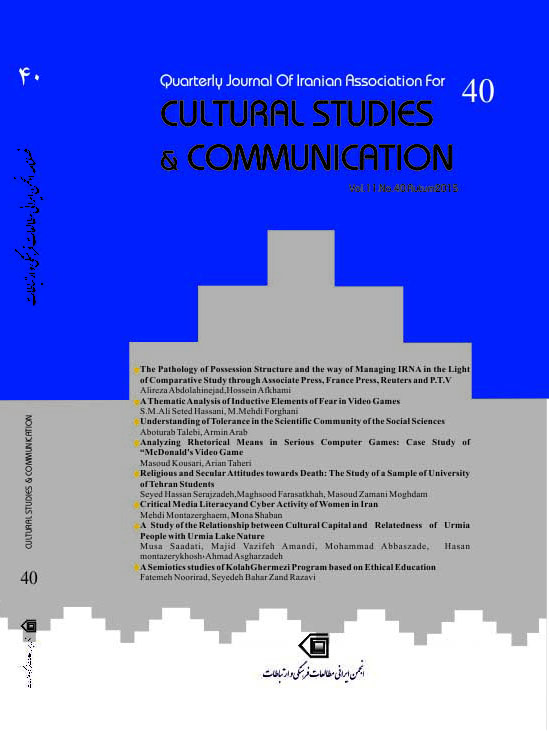- احمدی، محمد (1389) « مطالعه سواد دیجیتالی دانشجویان کارشناسی دانشگاه تهران و ارایه چهارچوبی برای ارتقا سواد دیجیتال»، پایاننامه کارشناسی ارشد رشته علوم ارتباطات اجتماعی دانشکده علوم اجتماعی.
- باکینگهام،دیوید (1389) آموزش رسانهای ( یادگیری، سواد رسانهای و فرهنگ معاصر)، ترجمه حسین سرفراز، تهران: دانشگاه امام صادق(ع).
- بیکر، ترزال (1377) نحوه انجام تحقیقات اجتماعی، ترجمه هوشنگ نایبی، تهران: روش
- پاتر، جیمز(1391) بازشناسی رسانههای جمعی با رویکرد سواد رسانهای، ترجمه یزدیان و دیگران، قم: صدا و سیمای جمهوری اسلامی ایران، مرکز پژوهشهای اسلامی.
- حاجی حیدری، حامد و یزدیان، حمید (1390) « سنجش و کاربست الگوی پنج سطحی سواد رسانهای انتقادی: مطالعه موردی دانشجویان دانشکده صدا و سیمای ج.ا.ا.» مجله جهانی رسانه- نسخه فارسی، دوره 6، شماره 2، شماره پیاپی 12: 30- 57.
- خانیکی، هادی و بصیریان جهرمی، حسین (1392)«کنشگری و قدرت در شبکههای اجتماعی مجازی: مطالعه کارکردهای فیسبوک در فضای واقعی»، فصلنامه علوم اجتماعی، شماره61: 80-45
- دواس، دی.ای (1376) پیمایش در تحقیقات اجتماعی، ترجمه هوشنگ نایبی، تهران: نشر نی.
- دوالت، مارجوری ال (1385) روش رهایی بخش: مطالعات زنان پژوهش اجتماعی، ترجمه هوشنگ نایبی، تهران: دانشگاه تهران.
- راوردراد، اعظم (1382) « مشارکت زنان در رادیو و تلویزیون»، فصلنامه پژوهش زنان، دوره اول، شماره 5: 196-167.
- کورتز، نورمن (1384) مقدمهای بر آمار در علوم اجتماعی، ترجمه حبیب الله تیموری، تهران: نشر نی.
- ساروخانی، باقر (1385) روشهای تحقیق در علوم اجتماعی، تهران: موسسه مطالعات و تحقیقات فرهنگی.
- سیلوربلات، آرت و دیگران (1391) رویکردهایی به سواد رسانهای، ترجمه امیر یزدیان، قم: مرکز پژوهشهای اسلامی صدا و سیما.
- کاظمیپور، شهلا (1380)«خواست و مصلحت مخاطبان و چگونگی برقرار کردن ارتباط منطقی بین آنها»، پژوهش و سنجش، شماره 26: 96-83
- مک لافین، جانیس (1387)زنان و نظریه اجتماعی و سیاسی مناظرات و گفتگوهای جاری، ترجمه حمیرا مشیرزاده، تهران: شیرازه.
- نصیری، بهاره (1389) «نقش سواد در نظام آموزش»، پایاننامه دکترا رشته علوم ارتباطات اجتماعی، دانشگاه آزاد واحد علوم تحقیقات.
- ونزونن، لیزبت (1383) « رویکردهای فمینیستی به رسانهها»، ترجمه محمدضا حسنزاده و حسن رئیسزاده، فصلنامه رسانه، سال پانزدهم، شماره1: 196-155.
- Alvermann, D. E.,& Hagood, M. (2000). "Critical Media Literacy: Research, Theory, and Practice in “New Times”" .The Journal of Educational Research, (93)3,193-205.
- Ashley, S. A., Maksel, A.,& Craft, S. (2013)."Developing a News Media Literacy Scale".Journalism & Mass Communication Educator,(68)1,7-21.
- Berry, D .(2008). Journalism, Ethics and Society. Ashgate Publishing, Ltd.
- Bowman, S., &Willis, C. (2003).We Media: How Audiences Are Shaping the Future of News and Information. Reston, VA: Media Center, American Press Institute.
- Chamberlain, K. (2010). "Redefining Cyberactivism: The Future of online Project".The Review of Communication,(4)3–4,139–146.
- Craft, S., Maksl, A.,& Ashley, S. (2013). "Measuring News Media Literacy How Knowledge and Motivation Combine to Create News-Literate Teens" .Retrieved Fromhttp://Scholarworks.Boisestate.Edu/cgi/Viewcontent.Cgi?Article=1062 context=Communication_Facpubs accessed 20July 2013.
- European Commission (n.d.)."‘Media Literacy’, Audiovisual and Media Policies".Retrieved Fromhttp://ec.Europa.eu/Culture/Media/Media-Literacy, Accessed 15July 2013.
- H Anson, J. (2010)."MEDIA LITERACY". Retrieved from http://Centralspace.ucmo.Edu/xmlui/Bitstream/Handle/10768/23/JHenson LibraryScience.pdf?Sequence=1 Accessed 20July 2013.
- Hobbs, R. (2011). "The State of Media Literacy: A Response to Potter".Journal of Broadcasting & Electronic Media, (55)3, 419-430.
- Kavada, A.(2010).Activism Transforms Digital: The Social Movement Perspective. Mary, J. "Digital Activism Decoded: the new Mechanics of Change". Pp101-118. New York: International Debate Education Association. Retrieved fromhttp://www.cl.cam.ac.uk/~sjm217/Papers/Digiact10all.pdf
- Kellner, D., & Share, J. (2005). "Toward Critical Media Literacy: Core Concepts, Debates, Organizations, and Policy". Studies in the Cultural Politics of Education,(26)3,369_386.
- Mitra,A. (2008). "Using Blogs to Create Cybernetic Space: Examples from People of Indian Origin".Convergence,14(4),457- 473.
- Morris, D.,& Langman, L.(2002). "Networks of Dissent: A Typology of Social Movements in a Global Age". Retrieved fromis.njit.edu/vci/iwci1/Morris-Networks-Dissent.doc
- Ng, M. (2012). "Contemporary Female Activism: Female Activists and Social Movements in the Cyber-Era". Retrieved from http://legalstudies.berkeley.edu/files/2012/05/Ng_Melody_Honors-Thesis.pdf
- Okello-Orlale, R. (2011). "Media and Information Literacy and Women, the Case of Sub-Saharan Africa".Retrieved fromhttp://www.Genderlinks.org.za/Attachment.php?aa_id=13303
- Papacharissi, Z.(2000). "The Virtual Sphere: The Internet as a Public Sphere". New Media & Society, 4(1), 9–27.
- Rich, M. (2004). "Health Literacy via Media Literacy: Video Intervention/ Prevention Assessment". American Behavioral Scientist,48(2), 165-188.
- Sayers, T. (1998). "Cyberfeminism in Canada: Women, Women's Organizations, The Women's Movement and Internet Technology". A thesis submitted to the Department of Sociology in Conformity with the Requirements for the Degree of Master of Arts.
- Schultz, D.,& Jungherr, A. (2010). "Applications: Picking the Right One in a Transient World". Mary, J. Digital activism Decoded: the new mechanics of change.Pp33-46. New York: International Debate Education Association .Retrieved from http://www.cl.cam.ac.uk/~sjm217/papers/digiact10all.pdf
- Thoman, E., & Jolls, T.( 2004). "Media Literacy – A National Priority for a Changing World". American Behavioral Scientist, (48)1,18 – 29.
- Thurlow, A. (1992). "Women, Media and Development: Alternative Media Programmes by and for Women: a Case Study in Jamaica". Master of Art in International Development Studies Saint Mary's University, Halifax, Nova Scoita.
- Tisdell, E. (2008). "Critical media literacy and Transformative learning: Drawing on pop Culture and Entertainment Media in Teaching for Diversity in Adult Higher Education". Journal of Transformative Education,(6)1, 48-67.
- Van Zoonen, L. (2002). "Gendering the Internet: Claims, Controversies and Cultures".European Journal of Communication,(17)1, 5-23.
- Voithofer, R.,& Winterwood, F. (2010). "Articulating and Contextualizing Multiple Literacies in an Urban Setting". Urban Education,(45)5,687.
